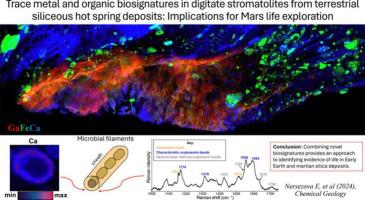当前位置:
X-MOL 学术
›
Chem. Geol.
›
论文详情
Our official English website, www.x-mol.net, welcomes your
feedback! (Note: you will need to create a separate account there.)
Trace metal and organic biosignatures in digitate stromatolites from terrestrial siliceous hot spring deposits: Implications for the exploration of martian life
Chemical Geology ( IF 3.6 ) Pub Date : 2024-05-29 , DOI: 10.1016/j.chemgeo.2024.122194 Ema E. Nersezova , Michael C. Rowe , Kathleen A. Campbell , Andrew Langendam , Cherie Tollemache , Barbara Lyon , Amanda Galar , Diego M. Guido , Bronwyn L. Teece , Trinity L. Hamilton
Chemical Geology ( IF 3.6 ) Pub Date : 2024-05-29 , DOI: 10.1016/j.chemgeo.2024.122194 Ema E. Nersezova , Michael C. Rowe , Kathleen A. Campbell , Andrew Langendam , Cherie Tollemache , Barbara Lyon , Amanda Galar , Diego M. Guido , Bronwyn L. Teece , Trinity L. Hamilton

|
Novel biosignatures of laminated, microbial, digitate sedimentary structures – stromatolites – from modern geothermal fields of the Taupō Volcanic Zone, New Zealand, and from El Tatio, Chile, provide an opportunity to investigate evidence of extremophile life preserved in siliceous hot spring deposits, or sinters, interpreted as analogs for early life on Earth and possibly Mars. Synchrotron-μXRF, electron microprobe analysis, Raman spectroscopy, and optical microscopy are used in a coordinated approach to identify corroborating textural and chemical (organic, inorganic) evidence of life in these modern, opaline (amorphous) siliceous materials. Fluid mobile elements, such as As and Sr, track the growth history of the digitate structures. Trace element enrichments of Ca, Al, Ga, +/− Fe, Mn, As, Rb, Cs, and Sr, are identified in silicified sheaths of microbial filaments embedded within the sinter. In contrast, silicified diatoms in some sinter samples show no trace element enrichment. Gallium enrichments have also been observed in other 16 ka and Jurassic (150 Ma) microbial palisade sinter textures, suggesting the potential for preservation through geologic time, even after recrystallization to quartz. Raman analysis reveals spectra of organics, consistent with pigments for UV protection in cyanobacteria, in silicified sheaths around microbial filaments and are co-located with trace metal enrichments in digitate structures. Due to spectral bands, the location of these molecules (i.e., in the sheaths), and the sampling locations, we ascribe the spectra to scytonemin and carotenoid class molecules. The combined analytical approach outlined here provides a robust means to assess the validity of novel biosignatures, with application to the exploration of Mars, where preservation of opaline silica in >3.6 Ga deposits has the potential to preserve a range of microbial biosignatures.
中文翻译:

陆地硅质温泉沉积物指状叠层石中的痕量金属和有机生物特征:对探索火星生命的意义
来自新西兰陶波火山带现代地热田和智利埃尔塔蒂奥的层状、微生物、数字沉积结构(叠层石)的新生物特征,为调查硅质温泉沉积物中保存的极端微生物生命的证据提供了机会,或者烧结体,被解释为地球和可能火星上早期生命的类似物。同步加速器μXRF、电子探针分析、拉曼光谱和光学显微镜以协调一致的方式使用,以鉴定这些现代乳色(无定形)硅质材料中确凿的结构和化学(有机、无机)生命证据。流体移动元素,如砷和锶,追踪数字结构的生长历史。在嵌入烧结矿的微生物丝的硅化鞘中发现了 Ca、Al、Ga、+/- Fe、Mn、As、Rb、Cs 和 Sr 的微量元素富集。相比之下,一些烧结样品中的硅化硅藻没有表现出微量元素富集。在其他 16 ka 和侏罗纪(150 Ma)微生物栅栏烧结结构中也观察到镓富集,这表明即使在重结晶为石英之后,也有可能在整个地质时期保存下来。拉曼分析揭示了有机物的光谱,与蓝细菌中用于紫外线防护的颜料、微生物丝周围的硅化鞘中的有机物光谱一致,并且与指状结构中的痕量金属富集物位于同一位置。由于光谱带、这些分子的位置(即在鞘中)和采样位置,我们将光谱归因于双细胞素和类胡萝卜素类分子。 这里概述的组合分析方法提供了一种强有力的方法来评估新型生物特征的有效性,并应用于火星探索,在火星> 3.6 Ga沉积物中保存乳白二氧化硅有可能保存一系列微生物生物特征。
更新日期:2024-05-29
中文翻译:

陆地硅质温泉沉积物指状叠层石中的痕量金属和有机生物特征:对探索火星生命的意义
来自新西兰陶波火山带现代地热田和智利埃尔塔蒂奥的层状、微生物、数字沉积结构(叠层石)的新生物特征,为调查硅质温泉沉积物中保存的极端微生物生命的证据提供了机会,或者烧结体,被解释为地球和可能火星上早期生命的类似物。同步加速器μXRF、电子探针分析、拉曼光谱和光学显微镜以协调一致的方式使用,以鉴定这些现代乳色(无定形)硅质材料中确凿的结构和化学(有机、无机)生命证据。流体移动元素,如砷和锶,追踪数字结构的生长历史。在嵌入烧结矿的微生物丝的硅化鞘中发现了 Ca、Al、Ga、+/- Fe、Mn、As、Rb、Cs 和 Sr 的微量元素富集。相比之下,一些烧结样品中的硅化硅藻没有表现出微量元素富集。在其他 16 ka 和侏罗纪(150 Ma)微生物栅栏烧结结构中也观察到镓富集,这表明即使在重结晶为石英之后,也有可能在整个地质时期保存下来。拉曼分析揭示了有机物的光谱,与蓝细菌中用于紫外线防护的颜料、微生物丝周围的硅化鞘中的有机物光谱一致,并且与指状结构中的痕量金属富集物位于同一位置。由于光谱带、这些分子的位置(即在鞘中)和采样位置,我们将光谱归因于双细胞素和类胡萝卜素类分子。 这里概述的组合分析方法提供了一种强有力的方法来评估新型生物特征的有效性,并应用于火星探索,在火星> 3.6 Ga沉积物中保存乳白二氧化硅有可能保存一系列微生物生物特征。

































 京公网安备 11010802027423号
京公网安备 11010802027423号